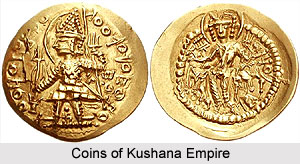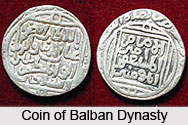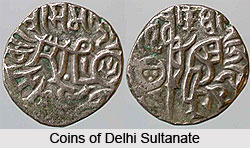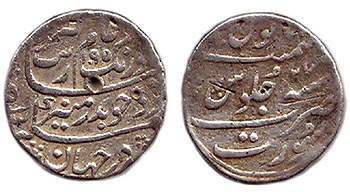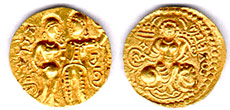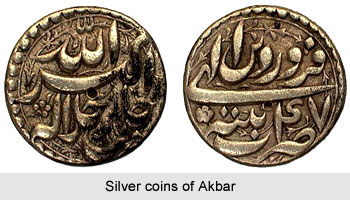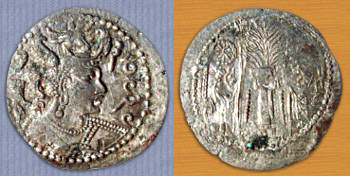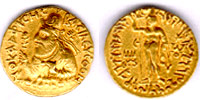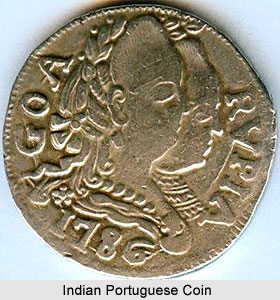 Independent kingdoms under the Muslim rule existed in the Eastern part of India as well and included the kingdoms of Assam region. These kingdoms issued some very striking coins, which generated considerable interest in Indian numismatics. These kingdoms were mostly isolated from the rest of the country. This serves as one of the major reasons of their coinage being of a very distinct style, different from those of the rest of India. The coinage of these kingdoms was essentially Hindu in style with Devnagri inscriptions, a rarity in 17th century of India due to massive Mughal expansion and extensive mintage of coins in Islamic style.
Independent kingdoms under the Muslim rule existed in the Eastern part of India as well and included the kingdoms of Assam region. These kingdoms issued some very striking coins, which generated considerable interest in Indian numismatics. These kingdoms were mostly isolated from the rest of the country. This serves as one of the major reasons of their coinage being of a very distinct style, different from those of the rest of India. The coinage of these kingdoms was essentially Hindu in style with Devnagri inscriptions, a rarity in 17th century of India due to massive Mughal expansion and extensive mintage of coins in Islamic style.
Assam or Ahom was an independent Hindu kingdom, better known in ancient literature as Kamrup. This Kingdom was located in fertile Brahmaputra river valley. Sukhampa founded it in the 13th century. During the height of Mughal expansion, Mir Jumla, Aurangzeb`s governor occupied Assam briefly. Muslim army could not keep control of Assam long and retreated within few months. Never again Assam was attacked by Muslims and remained fully independent.
Early rulers of this kingdom issued very interesting coinage. In spite of its foundation in 13th century, Assam did not issue coins of it`s own till mid-17th century. Chakradhwaja Simha (1663-1670 AD) was the first ruler who started issuing coins for this Kingdom. Being staunch Hindu, his earliest coins had legends written in Sanskrit (Devnagri script) but later he also issued coins with legends written in Assamese (Ahom) language.
Since 1467 A.D, the kings of Assam had been issuing coins. The first coin was issued by Ratnamanikya with inscriptions on both sides and later a grotesque lion was introduced on the reverse of the coin. Later devices like `trisula`, figure of Ardhanarisvara, figure f the flute playing Krishna flanked by a Gopi on either side in the upper half of the flan and the lion-trisula device in the lower half were used. Some of the kings used epithets that stood for their religious leanings. Ratnamanikya, the earliest ruler, used the epithet `Narayana-charanaparah` on the coins. Some of the later kings used `Siva-Kalika-pada-padama-madhukara` and some referred to `Radha-krishna-pada`. Some of the kings of this dynasty used the names of their queens on the coins.
The coins of Assam also include octagonal coins, a striking shape, which was never seen in other parts of India. This octagonal silver rupee coin weighed 11.3 grams and had a lion carved at the bottom of it. It had legends imbibed in the Ahom language. It was believed that Assam Kingdom is octagonal in shape, which inspired King to issue coins depicting octagonal geography of this kingdom. A historical manuscript mentions that coins were octagonal to indicate the eight kingdoms subjugated by the Ahoms while another historical document states that they were so shaped because the Ahom kingdom was described as being eight-sided. A third explanation states that coins of the Sultans of Bengal bore their legend in an enclosure surrounded by eight ornamental arcs and that it is this octagonal border that influenced the Ahom coinage. The fourth explanation links the shape to `tantricism` (very popular in Assam at the time), which involved the worship of diagrams. It is also suggested that as the people had never seen such a large kingdom as under the Ahoms, they expressed the Ahom domain as that stretched in the eight directions off earth and space conceived by the Hindus. The earliest coins were issued by the king Su-seng-pha (Jayadhvaja Singh) in 1648 A.D. Though the shape of the coin was introduced by the Ahomese kings, they borrowed the weight standard from the silver `tankah` of the Sultans of Bengal. These coins were issued in two types. One was on the occasion of coronation, bearing, in the Ahomese language and script, their Ahomese name and date in the year of 60 year cycle. The other type was for general circulation that contained Assamese script with the Indian names of the rulers and the date in the Saka years.
Ahom coinage makes fascinating study as it offers a unique case of tracing history and evolution of a culture and an economy, from it unearthed coins, dated to a relatively short period of about 200 years. The early Ahom economy, based on agriculture and barter, was characteristic of a non-monetized economy. The Ahom kings gave incentives to farmers and soldiers and surplus grain was exchanged for foreign goods. But over time, responding to the limitations of barter transactions, the Ahom ruler started issuing coins to facilitate indirect exchange. Though there are early references to coins being issued by rulers in obeisance to deities as well as later references to the minting of coins on the accession to the throne of Ahom princes or religious grants, the earliest discovered rupee coins are of Jayadhawaja Simha issued in 1648 A.D. other coins are of subsequent rulers who gradually issued smaller denominations along with an increase in the overall volume of coined money. This increasing monetization of the economy indicated its increasing economic development, and by the early 19th century, the Ahom economy emerged as a money economy.
The later rulers of Assam issued some coins that were square in shape and bore a Persian legend and the distiches employed on them. This style is said to be the imitation of the Mughal style of issuing coins. One of the later rulers, Rajeswara Simha also issued Persian on some of his coins. The series of Koch coins began with the Naranarayana`s coins which were issued in 1555 A.D. The Koch kingdom was established by Naranarayana`s father on the ruins of the earlier kingdom of Kamtapur. With the death of Naranarayana, the kingdom was divided between his son Lakshminarayana and his brother`s son Raghudeva. Both of them issued coins during their ruling period. The western kingdom of Lakshminarayana became a tributary of the Mughal Empire and since then its coinage became confined to the issue of half coins. These half coins were known as `Narayani` rupees and were struck with dies bigger than the flan. The exceptions to these were the coins of Prananarayana bearing the date of his accession. These coins bore a legend on the both sides of the coin. Naranarayana`s coins bore `Sri Sri Sivacharana-kamala madhukarasya` on one side and `Sri Sriman-Naranarayana bhupalasya Sake` followed by the date on the other side of the coin. His successors used the similar devices along with their names.
During the later period, some coins were issued with the inscription of `Shiva` which was replaced by `Hara-Gauri`. Even some coins were issued in the name of Aurangazeb during the occupation of Kuch-Behar by Mir Jumla in 1661 A.D. later its name was changed to Alamgirpur. These coins were similar to the Narayani rupees of the Koch rulers and also had he inscription in Assamese script instead of Persian. The coins of Kacharis were very similar to the coins of Koch. These coins bore the expression of devotion to some deity on the obverse side and the name of the king and the date on the reverse side of the king. Over the Jayantia Hills and the adjoining Jayantia pargana in the Surma valley, the Jayantia king ruled. As per the historical evidences they issued coins. The earliest coins of this kingdom were believed to be dated Saka 1591 or 1669 A.D. Some evidences prove that the rulers of this dynasty issued coins in gold and it bore the date Saka 1502. As per the evidence, the rulers used to issue coins only on occasion of their accession to the throne. The coins bore the expression of devotion to a deity on one side and `Sri Sri Jayantapura-purendarasya` with the date in Saka era on the flip side of the coin. The expression of devotion to a deity changed with the ruler. Some of the coins issued during this time bore the name of the king.
During 18th century Assam Kingdom weakened due to internal civil war and later attack by Burmese army. Coins of different denominations were in circulation within the Ahom kingdom. Gold coins were rarely used for transactions, which were mostly carried out in silver coins, and for small transactions, cowries were used. Brajanath Simha, who briefly gained control of the region in 1818-19, struck copper coins, for the first time in the numismatic history of Assam, which are believed to represent the 128th and 64th part of a rupee. Eventually in 1882, Burmese occupied Assam completely. British who were ruling in neighboring Bengal could not resist the temptation of adding Assam to their own growing empire. They acted swiftly, defeated Burmese army in 1884 and took control of the Kingdom, which remain part of British Empire till 1947. On independence, it was incorporated in Republic of India as Assam State.
